Pest
PhpStorm comes with support for the Pest testing framework. You can run, run with code coverage, or debug Pest tests, run Pest tests in parallel and, with Pest 3.0 and later, run Pest mutation testing from PhpStorm.
The IDE understands the Pest expectation API, so you can use code completion, find usages, and other coding assistance features when working with Pest assertions and the user-defined test methods.
Install and initialize Pest
To install Pest from within PhpStorm:
Inside composer.json, add the
pestphp/pestdependency record to therequireorrequire-devkey. To get code completion for the package name and version, press Ctrl+Space.Do one of the following:
Click the Install shortcut link on top of the editor panel.
If the Non-installed Composer packages inspection is enabled, PhpStorm will highlight the declared dependencies that are not currently installed. Press Alt+Enter and select whether you want to install a specific dependency or all dependencies at once.
In the Terminal tool window, execute the
./vendor/bin/pest --initcommand to initialize Pest in your current PHP project and add the tests folder with example test files and the phpunit.xml configuration file at the root level of your test suite.
Clicking next to the package record in the composer.json editor gutter will take you to the corresponding Settings page where you can configure Pest manually.

Integrate Pest with a PhpStorm project
If you use a local PHP interpreter, PhpStorm performs initial Pest configuration automatically. In the case of remote PHP interpreters, manual Pest configuration is required.
Configure Pest automatically
When you install Pest in your project, PhpStorm detects the installed Pest executable and creates a test framework configuration on the Test Frameworks page.

If the phpunit.xml or phpunit.xml.dist configuration file is detected under the project (or subproject) root automatically or specified explicitly during manual configuration, PhpStorm also creates a respective Pest run/debug configuration.

Configure Pest manually
In the Settings dialog (Ctrl+Alt+S) , go to .
On the Test Frameworks page that opens, click
in the central pane and choose the configuration type from the list:
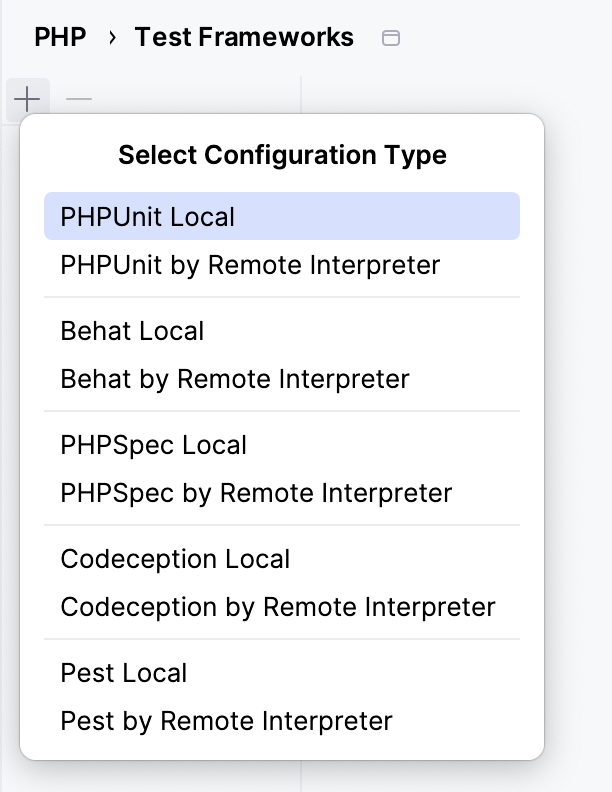
In local configurations, the default project PHP interpreter is used. For more information, refer to Default project CLI interpreters.
To use Pest with a remote PHP interpreter, choose one of the configurations in the dialog that opens:
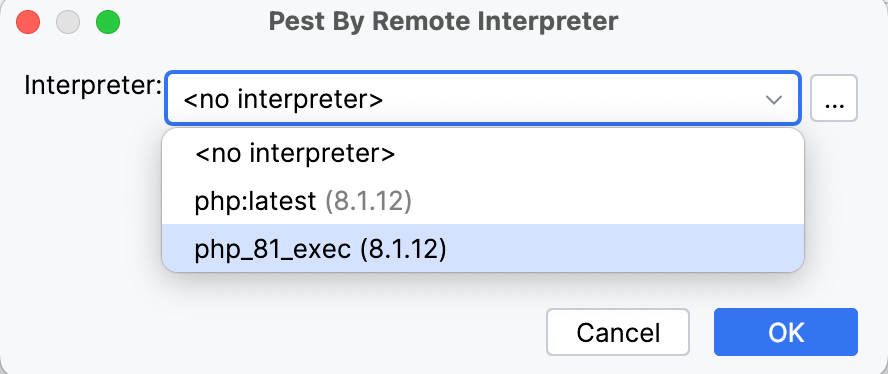
In the Test Runner area, set the path to the configuration XML file to be used for launching and executing scenarios.
Generate a Pest test for a class
In the editor, place the caret at the definition of the PHP class to be tested, press Alt+Enter and select Create New Test from the popup menu. This way, you can generate a test for a PHP class defined among several classes within a single PHP file.
To create a test for a certain method, place the caret within the method declaration. The chosen method will be automatically selected from the list of methods in the Create New PHP Test dialog.
In the Create New PHP Test dialog that opens, provide the parameters of the generated test.
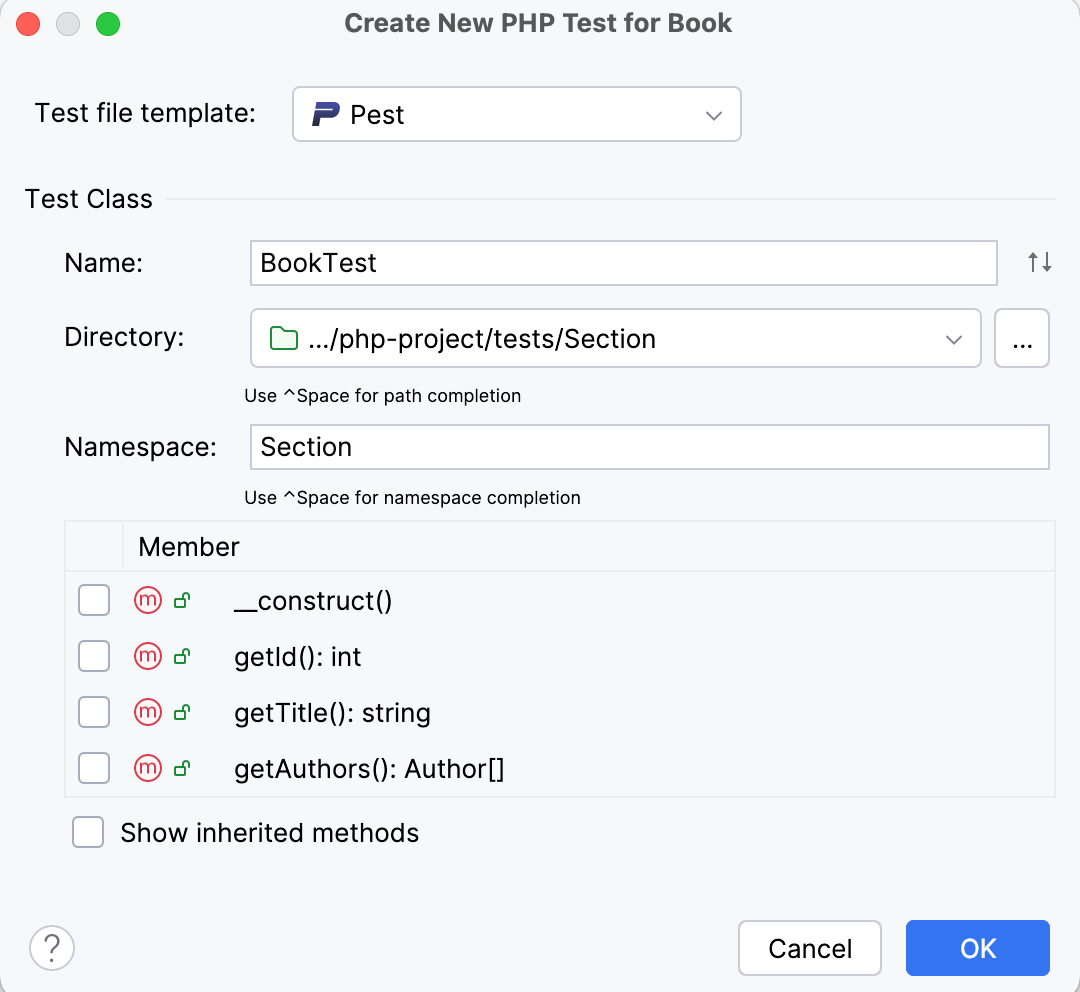
Test file template: the template based on which PhpStorm will generate the test class. Make sure that Pest is selected from the list.
Name: the name of the test class. PhpStorm automatically composes the name from the production class name as .
Directory: the folder for the test class file, which is automatically suggested based on the containing directory and namespace of the production class, the configured test sources root and its PSR-4 package prefix, or the value specified in the configuration file.
To specify a different folder, click
next to the Directory field and choose the relevant folder.
Namespace: the namespace the test class will belong to, which is automatically suggested based on the containing directory and namespace of the production class, the configured test sources root and its psr-4 package prefix.
Member: the list of production class methods to generate test method stubs for. Select the checkboxes next to the required production class methods. To include inherited methods from parent classes, select the Show inherited methods checkbox.
PhpStorm will automatically compose the test methods' names as
test<production method>. You can customize the code templates used for generating test method stubs on the Code tab of the File and Code Templates settings page.
After the test is created, you can navigate back to the production class by choosing Navigate | Go to Test Subject. For more information, refer to Navigate between a test and its test subject.
Run and debug Pest tests
You can run and debug single tests as well as tests from entire files and folders. You can also run Pest tests in parallel and, with Pest 3.0 and later, run Pest mutation testing from PhpStorm.
PhpStorm creates a run/debug configuration with the default settings and launches the tests. You can later save this configuration for reuse.
Run or debug Pest tests
There are several alternative ways to run Pest tests in PhpStorm:
From the Project tool window: select the file or folder to run your tests from and choose Run '<file or folder>', Debug '<file or folder>', or More Run/Debug from the context menu of the selection.
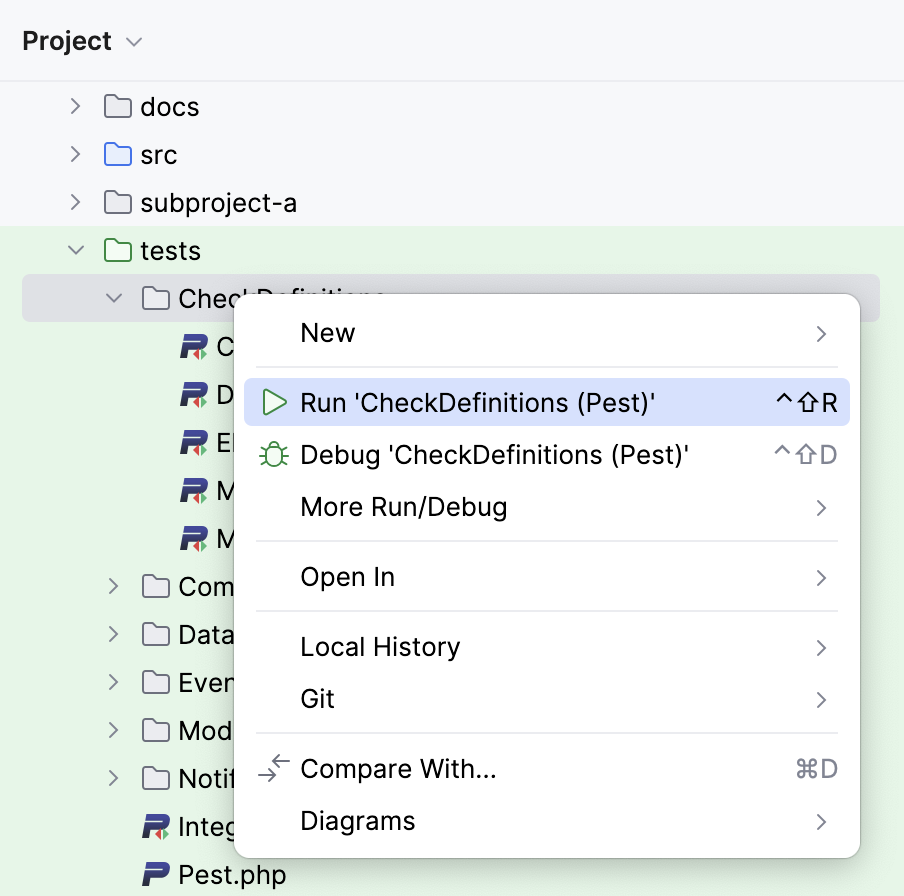
From the file editor window: open the test file in the editor, click
in the gutter next to the test and choose Run '<test_name>', Debug '<test_name>', Run '<test_name>' in Parallel, or Run '<test_name>' with Mutation from the context menu.
Alternatively, place the caret at the corresponding line and press Ctrl+Shift+F10.
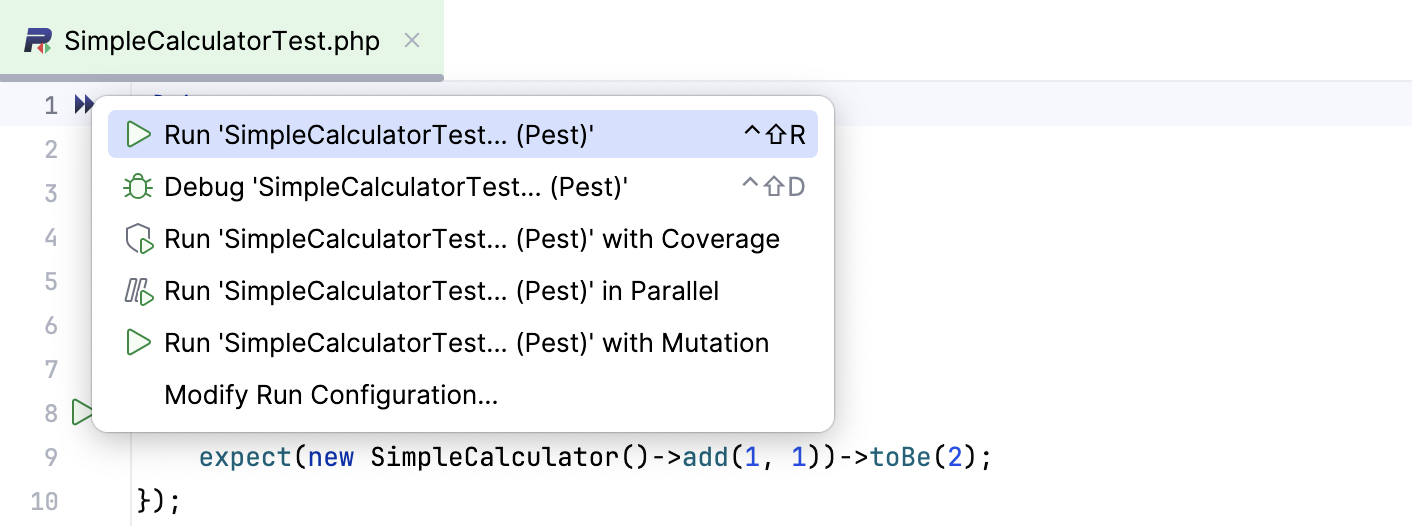
From the Run widget: select Current File from the drop-down list, and then click
or
to run or debug the currently open test file, or click
 to select a Run '<test_name>' in Parallel or Run '<test_name>' with Mutation option.
to select a Run '<test_name>' in Parallel or Run '<test_name>' with Mutation option. 
PhpStorm generates a default run configuration and starts a run or debug test session with it.
Resume paused execution
In Pest 4.0 and later, running browser tests with the debug() method pauses the execution and opens the browser window. To resume the test execution in PhpStorm, click the Continue Test Run button on the toolbar.

Navigate Pest tests
To quickly navigate to a specific test in the test file, use the file structure view. Place the caret anywhere in the open file and press Ctrl+F12 to open the File Structure popup.

Pressing Alt+7 opens the file structure in the Structure tool window.
Save configuration as permanent
After a test session is over, choose Save Configuration from the context menu of the respective run/debug configuration in the run widget.
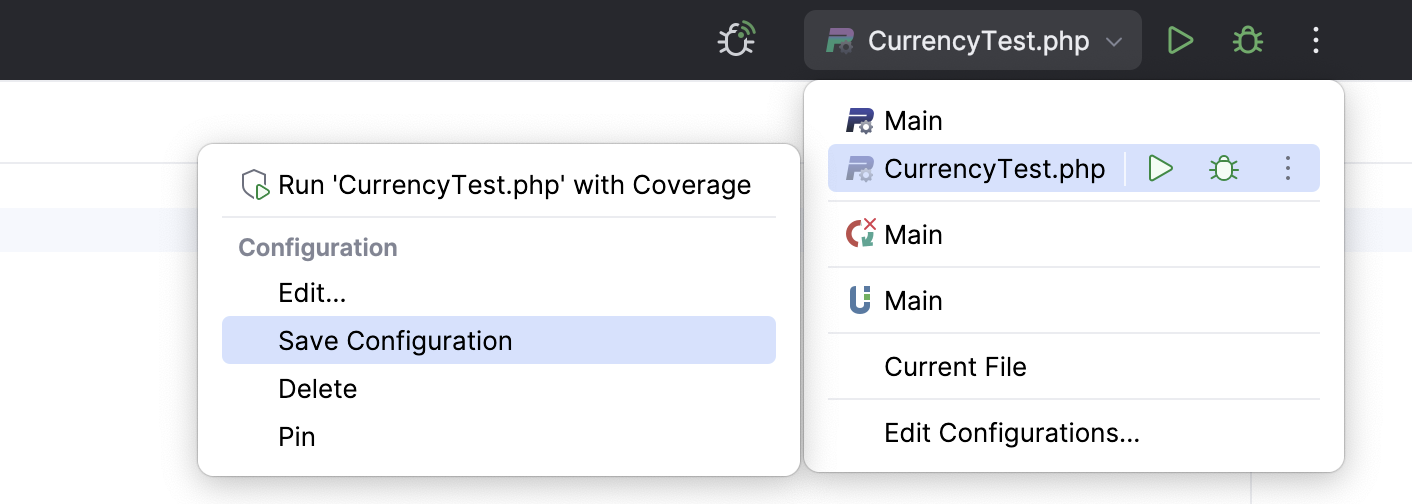
Run a saved run/debug configuration
Choose the required Pest configuration from the list on the toolbar and click
or
.
Create a custom run/debug configuration
In the Project tool window, select the file or folder with the tests to run and choose Create run configuration from the context menu. Alternatively, go to in the main menu, then click
and choose Pest from the list.
In the Pest dialog that opens, specify the scenarios to run, choose the PHP interpreter to use, and customize its behavior by specifying the options and arguments to be passed to the PHP executable.
Monitor test results
PhpStorm shows the tests execution results in the Test Runner tab of the Run tool window.
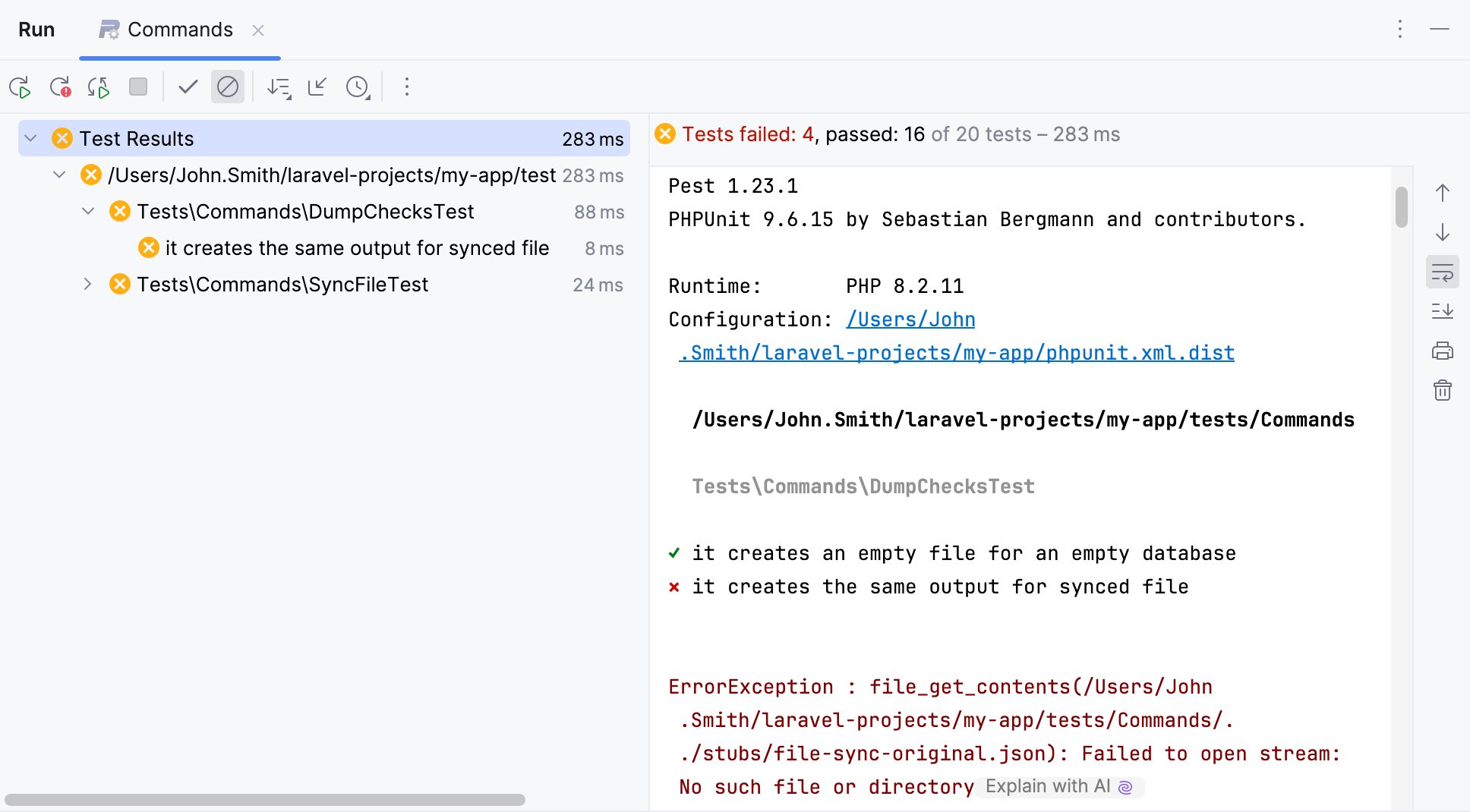
The tab is divided into 2 main areas:
The left-hand area lets you drill down through all unit tests to see the succeeded and failed ones. You can filter tests, export results, and use the context menu commands to run specific tests or navigate to the source code.
The right-hand area displays the raw Pest output.
Additionally, failed tests are highlighted in the file editor window.

Run Pest tests automatically
You can have PhpStorm re-run tests automatically when the affected code is changed. This option is configured per run/debug configuration and can be applied to a test, a test file, a folder, or a composite selection of tests, depending on the test scope specified in this run/debug configuration.
Run the tests.
On the Run toolbar, click
Rerun Automatically.

Optionally, set a time delay for launching the tests upon the changes in the code. To do so, on the Run toolbar, click
and select
Test Runner Settings | Set Auto-Test Delay.
